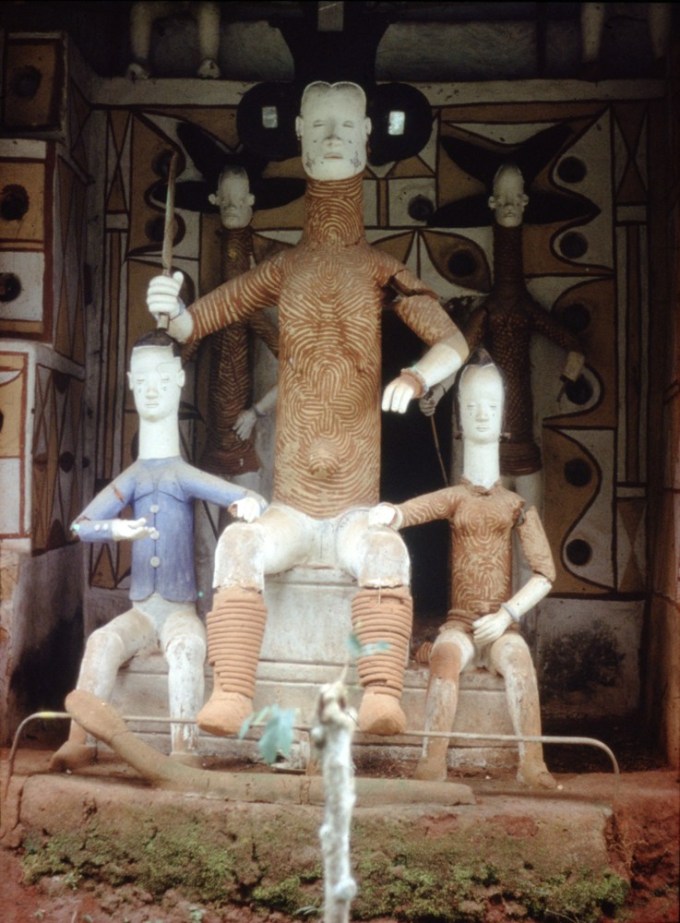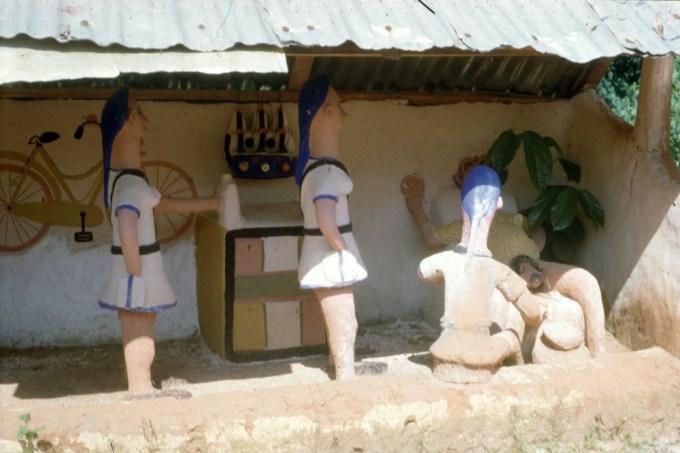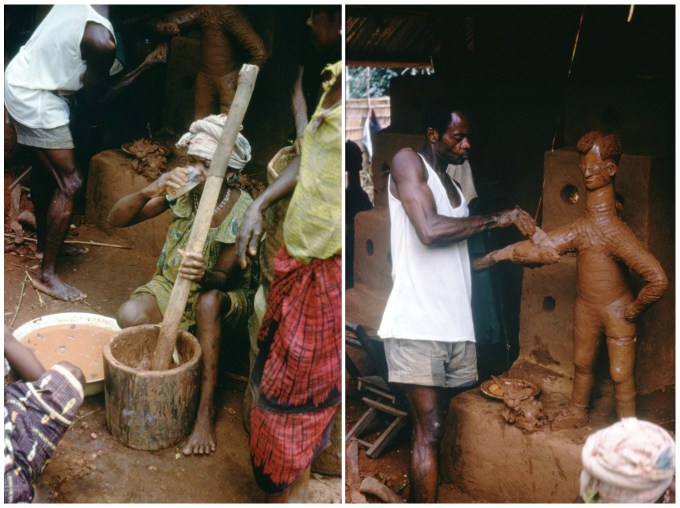“There is no rigid barrier between makers of culture and its consumers. Art belongs to all and is a ‘function’ of society.”
By Maria Popova
“The greatest poet in the English language found his poetry where poetry is found: in the lives of the people,” James Baldwin wrote in his superb meditation on Shakespeare. “Art must be life — it must belong to everybody,” Marina Abramović insisted in her artist life manifesto. Since long before Abramović, since long before Baldwin, since long before Shakespeare, the Igbo culture of Nigeria has embodied and enacted the notion that there is poetry — there is art and artistry — in the lives of the people, the ordinary people, unleashed into communal belonging through their ritual of mbari — the ceremonial celebration of the creative spirit, dedicated to the Earth goddess Ala.
 Chinua Achebe
Chinua Achebe
Chinua Achebe (November 16, 1930–March 21, 2013) explores what mbari can teach us about the crucial interleaving of art and society in a long-ago essay titled “Africa and Her Writers,” excerpted and discussed in Pipers at the Gates of Dawn: The Wisdom of Children’s Literature (public library) — Jonathan Cott’s collection of erudite, sensitive, soaring conversations with such titans of feeling in word and image as Maurice Sendak, Dr. Seuss, and Astrid Lindgren, originally published just before I was born (and reprinted in 2020 with a foreword I had the joy of writing).
Achebe writes of the mbari temple as a spare but striking structure that, despite its simplicity, often becomes “a miracle of artistic achievement — a breathtaking concourse of images in bright, primary colors,” sculpted from Ala’s own material — “simple molded earth.”
 Figure of Ala in an mbari. (Photograph: Herbert M. Cole. University of Iowa Stanley Museum of Art.)
Figure of Ala in an mbari. (Photograph: Herbert M. Cole. University of Iowa Stanley Museum of Art.)
Achebe describes its making and makers:
Every so many years Ala would instruct the community through her priest to prepare a festival of images in her honor. That night the priest would travel through the town, knocking on many doors to announce to the various household whom of their members Ala had chosen for the great work. These chosen men and women then moved into the seclusion in a forest clearing and, under the instruction and guidance of master artists and craftsmen, began to build a house of images. The work might take a year or even two, but as long as it lasted the workers were deemed to be hallowed and were protected from undue contact from, and distraction by, the larger community.
What emerges from this tradition is the bold, unfussy affirmation that art is not only a form of consciousness accessible to all but a form of citizenship — that the responsibility for its making, the right of its enjoyment, and the dialogue between the two are an essential and natural part of our civic conscience. Achebe writes:
The making of art is not the exclusive concern of a particular caste or secret society. Those young men and women whom the goddess chose for the re-enactment of creation were not “artists.” They were ordinary members of society. Next time around, the choice would fall on other people. Of course, mere nomination would not turn everyman into an artist — not even divine appointment could guarantee it. The discipline, instruction, and guidance of a master artist would be necessary. But not even a conjunction of those two conditions would insure infallibly the emergence of a new, exciting sculptor or painter. But mbari was not looking for that. It was looking for, and saying, something else: There is no rigid barrier between makers of culture and its consumers. Art belongs to all and is a “function” of society.
 Mbari depicting a maternity clinic with three uniformed nurses attending to a woman in the act of giving birth. (Photograph: Herbert M. Cole. University of Iowa Stanley Museum of Art.)
Mbari depicting a maternity clinic with three uniformed nurses attending to a woman in the act of giving birth. (Photograph: Herbert M. Cole. University of Iowa Stanley Museum of Art.)
Achebe recognizes that while this notion may be a natural part of the “holistic concern” of traditional societies, it is “abominable heresy in the ears of mystique lovers” — the ego-pricked ears of those who exalt the artist as a special class of citizen, apart from and above the rest of society. With a wry wink, Achebe offers a necessary disclaimer “for their sake and their comfort.” Echoing Thoreau’s distinction between an artisan, an artist, and a genius, he writes:
The idea of mbari does not deny the place or importance of the master with unusual talent and professional experience. Indeed it highlights such gift and competence by bringing them into play on the seminal potentialities of the community. Again, mbari does not deny the need for the creative artist to go apart from time to time so as to commune with himself, to look inwardly into his own soul. For when the festival is over, the villagers return to their normal lives again, and the master artists to their work and contemplation. But they can never after this experience, this creative communal enterprise, become strangers again to one another. And by logical and physical extension the greater community, which comes to the unveiling of the art and then receives is makers again into its normal life, becomes a beneficiary — indeed an active partaker — of this experience.
 “Spirit worker” pounding clay from anthills for the apprentice artist to sculpt with. (Photograph: Herbert M. Cole. University of Iowa Stanley Museum of Art.)
“Spirit worker” pounding clay from anthills for the apprentice artist to sculpt with. (Photograph: Herbert M. Cole. University of Iowa Stanley Museum of Art.)
Complement this slender portion of Cott’s wholly magnificent Pipers at the Gates of Dawn with Achebe on how storytelling helps us survive history’s rough patches and his superb forgotten conversation with James Baldwin, then revisit Baldwin on what it means to be an artist and Iris Murdoch on why art is essential for democracy.






